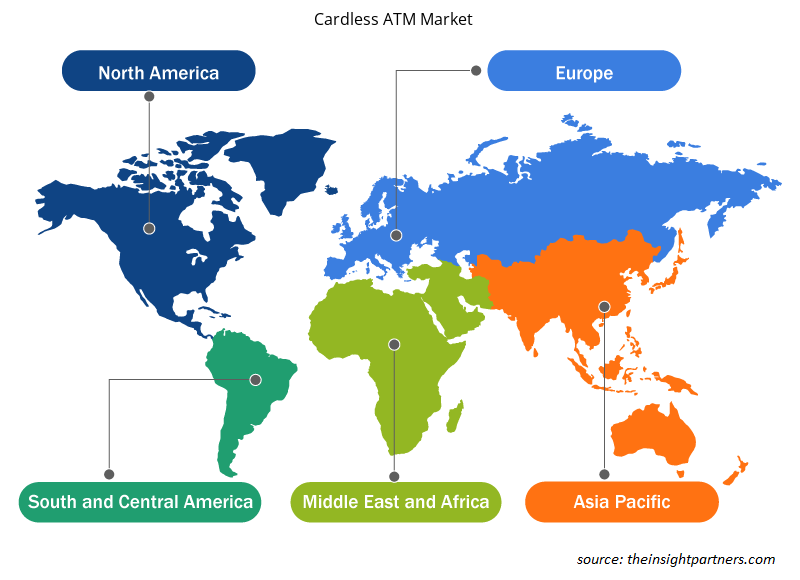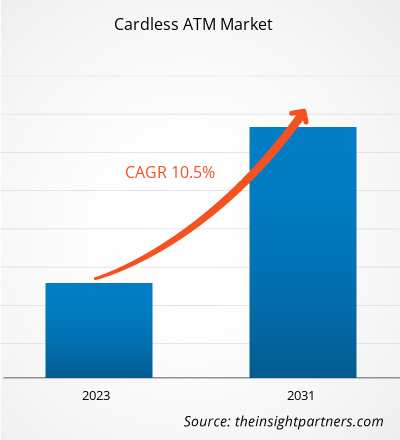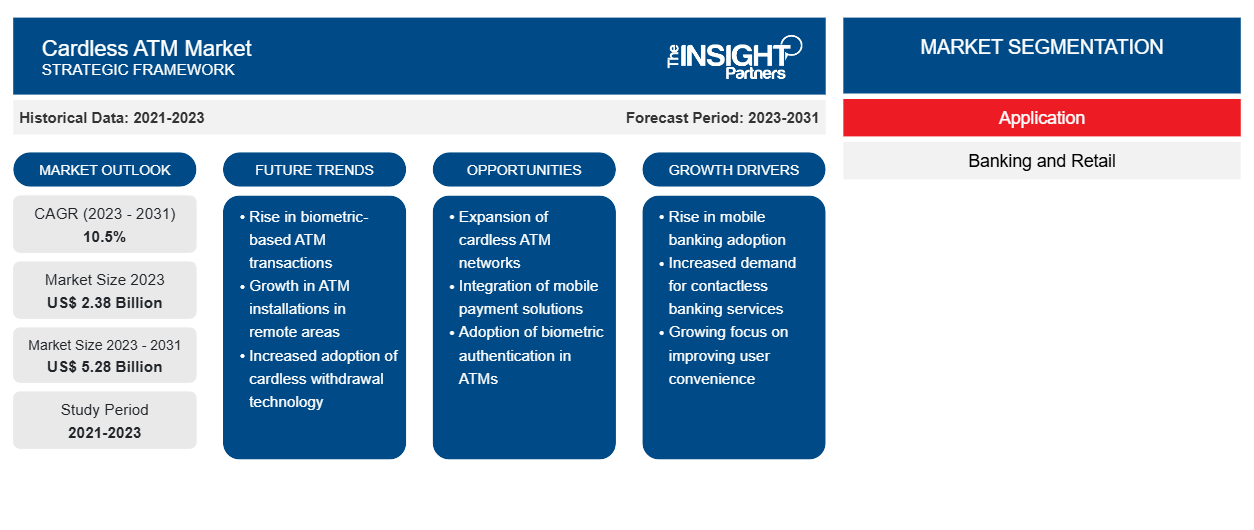Se espera que el tamaño del mercado de cajeros automáticos sin tarjeta crezca de US$ 2.38 mil millones en 2023 a US$5.28 mil millones para 2031; se prevé que se expanda a una CAGR del 10,5% entre 2023 y 2031. La transformación digital también ha impactado positivamente al sector bancario. Se está adoptando tecnología para aumentar la accesibilidad y la comodidad para los consumidores en el sector bancario. En esta dirección, los bancos de todo el mundo están introduciendo cada vez más plataformas móviles, banca digital y autenticación biométrica para ofrecer soluciones mejores y más accesibles a los consumidores. A raíz de estos avances, la participación de mercado de los cajeros automáticos sin efectivo también está experimentando un aumento en todo el mundo.
Análisis del mercado de cajeros automáticos sin tarjeta
El pronóstico del mercado de cajeros automáticos sin tarjeta se estima sobre la base de varios hallazgos de investigación primaria y secundaria, como publicaciones de empresas clave, datos de asociaciones y bases de datos. La tecnología digital ha alterado la industria bancaria, mejorando la eficiencia y la accesibilidad. Si bien la tecnología financiera reduce la necesidad de transacciones frecuentes en efectivo, también facilita la obtención de efectivo cuando el consumidor lo necesita. Los cajeros automáticos sin tarjeta permiten a los clientes completar transacciones en cajeros automáticos utilizando la aplicación bancaria de su teléfono inteligente. Son una forma sencilla de retirar dinero de una cuenta bancaria si uno olvida su tarjeta de débito o desea reducir la cantidad de veces que el consumidor tiene que tocar la pantalla de un cajero automático. Este es uno de los principales factores que impulsan el crecimiento del mercado de cajeros automáticos sin tarjeta a nivel mundial.
Cajero automático sin tarjeta
Panorama de la industria
- Las cuentas de cajeros automáticos sin tarjeta mejoran la seguridad al eliminar la necesidad de tarjetas reales, simplificar los procesos de transacción y brindar servicios bancarios móviles. A medida que más personas utilizan los servicios financieros formales, el sector bancario se centra cada vez más en las cuentas de cajeros automáticos sin tarjeta.
- Los cajeros automáticos que utilizan tarjetas físicas enfrentan dificultades como robo, pérdida y acceso no autorizado, lo que resalta la necesidad de nuevas soluciones.
- Las cuentas de cajeros automáticos sin tarjeta, que utilizan aplicaciones de banca móvil y autenticación biométrica, ofrecen una alternativa segura a las tarjetas físicas. Los mecanismos de autenticación avanzados mejoran la seguridad y mitigan los riesgos asociados con el uso de tarjetas físicas.
- Las cuentas de cajeros automáticos sin tarjeta son populares debido a que permiten un proceso de transacción más rápido y son más fáciles de usar. Los dispositivos móviles permiten autorizar transacciones de forma segura sin necesidad de tarjetas físicas, lo que aumenta la accesibilidad a los servicios bancarios.
Personalice este informe según sus necesidades
Obtendrá personalización en cualquier informe, sin cargo, incluidas partes de este informe o análisis a nivel de país, paquete de datos de Excel, así como también grandes ofertas y descuentos para empresas emergentes y universidades.
-
Obtenga las principales tendencias clave del mercado de este informe.Esta muestra GRATUITA incluirá análisis de datos, desde tendencias del mercado hasta estimaciones y pronósticos.
Impulsor del mercado de cajeros automáticos sin tarjeta
El auge de la banca móvil en todo el mundo impulsará el mercado de cajeros automáticos sin tarjeta
- Con el auge de la banca digital y las transacciones en línea en la era pospandémica, la dependencia de los cajeros automáticos disminuyó. La aplicación de los cajeros automáticos está en tela de juicio con el creciente movimiento hacia economías sin efectivo en todo el mundo. Esto impulsó al sector bancario y a los proveedores de cajeros automáticos a repensar la tecnología, y esto los impulsó a ofrecer cajeros automáticos sin efectivo a los consumidores.
- Los cajeros automáticos sin tarjeta se consideran la "próxima gran tendencia" en el sector bancario. Instituciones importantes como Bank of America y Chase ya han implementado cajeros automáticos sin tarjeta. Según Wilson Kerr de Unbound Commerce, "a medida que la tecnología biométrica mejore y proteja las medidas de acceso a través de teléfonos inteligentes, innovaciones como los cajeros automáticos sin tarjeta se convertirán en la norma".
- Entre los avances más recientes, los códigos QR en los cajeros automáticos sin tarjeta se están expandiendo a un ritmo sin precedentes.
- Estos cajeros automáticos sin tarjeta son mucho más fáciles de instalar y menos costosos de mantener. En diciembre de 2021, uno de los proveedores de plataformas de pagos y banca digital del mundo, CR2, anunció hoy que ha proporcionado esta solución de retiro de efectivo en cajeros automáticos sin intervención para uno de los bancos más progresistas del continente africano en la actualidad. Los cajeros automáticos sin efectivo atraen a los usuarios de banca móvil más sofisticados, y esto ha impulsado el crecimiento del mercado de cajeros automáticos sin tarjeta.
Cajero automático sin tarjeta
Análisis de segmentación de informes de mercado
- Según la tecnología, el informe del mercado de cajeros automáticos sin tarjeta está segmentado en comunicación de campo cercano (NFC), códigos de respuesta rápida (QR) y verificación biométrica.
- Se espera que el segmento de comunicación de campo cercano (NFC) tenga una participación significativa en el mercado de cajeros automáticos sin tarjeta en 2023. Cuando el usuario toca su dispositivo móvil contra el símbolo de sin contacto en un cajero automático, la comunicación de campo cercano (NFC) inicia la aplicación de billetera digital de su teléfono. Desde la pantalla de la aplicación, el usuario puede seleccionar la tarjeta que desea usar e ingresar el PIN para completar la transacción en el cajero automático.
Cajero automático sin tarjeta
Análisis de mercado por geografía
El alcance del informe de mercado de cajeros automáticos sin tarjeta se divide principalmente en cinco regiones: América del Norte, Europa, Asia Pacífico, Oriente Medio y África, y América del Sur. América del Norte está experimentando un rápido crecimiento y se prevé que tenga una participación significativa en el mercado de cajeros automáticos sin tarjeta. El importante desarrollo económico de la región y el creciente uso de la tecnología de banca móvil están impulsando la adopción de cajeros automáticos sin tarjeta en la región. Según una estadística de 2023 de Fortunly, el 89% de los titulares de cuentas bancarias estadounidenses utilizan la banca móvil para la gestión de cuentas.
Cajero automático sin tarjeta
Perspectivas regionales del mercado de cajeros automáticos sin tarjeta
Los analistas de Insight Partners explicaron en detalle las tendencias y los factores regionales que influyen en el mercado de cajeros automáticos sin tarjeta durante el período de pronóstico. Esta sección también analiza los segmentos y la geografía del mercado de cajeros automáticos sin tarjeta en América del Norte, Europa, Asia Pacífico, Oriente Medio y África, y América del Sur y Central.

- Obtenga los datos regionales específicos para el mercado de cajeros automáticos sin tarjeta
Alcance del informe sobre el mercado de cajeros automáticos sin tarjeta
| Atributo del informe | Detalles |
|---|---|
| Tamaño del mercado en 2023 | US$ 2.38 mil millones |
| Tamaño del mercado en 2031 | 5.280 millones de dólares estadounidenses |
| CAGR global (2023 - 2031) | 10,5% |
| Datos históricos | 2021-2023 |
| Período de pronóstico | 2023-2031 |
| Segmentos cubiertos |
Por aplicación
|
| Regiones y países cubiertos |
América del norte
|
| Líderes del mercado y perfiles de empresas clave |
|
Densidad de actores del mercado de cajeros automáticos sin tarjeta: comprensión de su impacto en la dinámica empresarial
El mercado de cajeros automáticos sin tarjeta está creciendo rápidamente, impulsado por la creciente demanda de los usuarios finales debido a factores como la evolución de las preferencias de los consumidores, los avances tecnológicos y una mayor conciencia de los beneficios del producto. A medida que aumenta la demanda, las empresas amplían sus ofertas, innovan para satisfacer las necesidades de los consumidores y aprovechan las tendencias emergentes, lo que impulsa aún más el crecimiento del mercado.
La densidad de actores del mercado se refiere a la distribución de las empresas o firmas que operan dentro de un mercado o industria en particular. Indica cuántos competidores (actores del mercado) están presentes en un espacio de mercado determinado en relación con su tamaño o valor total de mercado.
Las principales empresas que operan en el mercado de cajeros automáticos sin tarjeta son:
- Grupo Citigroup Inc.
- Compañía: JP Morgan Chase & Co.
- Wells Fargo
- Corporación NCR
- Fujitsu
Descargo de responsabilidad : Las empresas enumeradas anteriormente no están clasificadas en ningún orden particular.

- Obtenga una descripción general de los principales actores clave del mercado de cajeros automáticos sin tarjeta
Análisis del mercado de cajeros automáticos sin tarjetaSe llevó a cabo en función del tipo, la tecnología, la aplicación y la geografía. En términos de tipo, el mercado está segmentado en cajeros automáticos in situ, cajeros automáticos externos y otros. Según la tecnología, el mercado de cajeros automáticos sin tarjeta está segmentado en comunicación de campo cercano (NFC), códigos de respuesta rápida (QR) y verificación biométrica. Según la aplicación, el mercado de cajeros automáticos sin tarjeta está segmentado en banca y comercio minorista. Según la geografía, el mercado está segmentado en América del Norte, Europa, Asia Pacífico, Oriente Medio y África, y América del Sur.
Cajero automático sin tarjeta
Noticias del mercado y desarrollos recientes
Las empresas adoptan estrategias orgánicas e inorgánicas, como fusiones y adquisiciones, en el mercado de cajeros automáticos sin tarjeta. A continuación, se enumeran algunos de los principales desarrollos recientes del mercado:
- En junio de 2016, Bank of America reveló el jueves que había inaugurado 19 cajeros automáticos en San Antonio que permiten a los usuarios retirar efectivo utilizando sus teléfonos inteligentes. Los clientes pueden realizar transferencias y consultar saldos en cajeros automáticos sin tarjeta utilizando una tarjeta de débito digital almacenada en su teléfono inteligente.
[Fuente: Bank of America, sitio web de la empresa]
- En septiembre de 2020, HSBC creó una tecnología propia basada en inteligencia artificial para optimizar las operaciones de recarga de efectivo en sus cajeros automáticos, que ahora están subcontratados a contratistas externos. La técnica se probó con éxito en la red de 1.200 cajeros automáticos del banco en Hong Kong. El banco ahorró hasta un millón de dólares porque la cantidad de recargas en los cajeros automáticos disminuyó en un 15% después de implementar la tecnología de inteligencia artificial "iCash".
[Fuente: HSBC Holdings Plc, sitio web de la empresa]
Cajero automático sin tarjeta
Cobertura y resultados del informe de mercado
El informe de mercado "Tamaño y pronóstico del mercado de cajeros automáticos sin tarjeta (2021-2031)" proporciona un análisis detallado del mercado que cubre las siguientes áreas:
- Tamaño del mercado y pronóstico a nivel global, regional y nacional para todos los segmentos clave del mercado cubiertos bajo el alcance.
- Dinámica del mercado como impulsores, restricciones y oportunidades clave.
- Principales tendencias futuras.
- Análisis PEST y FODA detallado
- Análisis del mercado global y regional que cubre las tendencias clave del mercado, los actores clave, las regulaciones y los desarrollos recientes del mercado.
- Análisis del panorama de la industria y la competencia que cubre la concentración del mercado, el análisis de mapas de calor, los actores clave y los desarrollos recientes.
- Perfiles detallados de empresas.
- Análisis histórico (2 años), año base, pronóstico (7 años) con CAGR
- Análisis PEST y FODA
- Tamaño del mercado, valor/volumen: global, regional y nacional
- Industria y panorama competitivo
- Conjunto de datos de Excel
Informes recientes
Testimonios
Razón para comprar
- Toma de decisiones informada
- Comprensión de la dinámica del mercado
- Análisis competitivo
- Información sobre clientes
- Pronósticos del mercado
- Mitigación de riesgos
- Planificación estratégica
- Justificación de la inversión
- Identificación de mercados emergentes
- Mejora de las estrategias de marketing
- Impulso de la eficiencia operativa
- Alineación con las tendencias regulatorias























 Obtenga una muestra gratuita para - Mercado de cajeros automáticos sin tarjeta
Obtenga una muestra gratuita para - Mercado de cajeros automáticos sin tarjeta